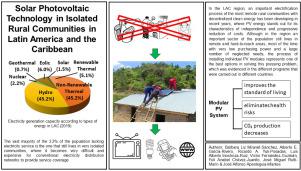当前位置:
X-MOL 学术
›
Energy Rep.
›
论文详情
Our official English website, www.x-mol.net, welcomes your
feedback! (Note: you will need to create a separate account there.)
Solar photovoltaic technology in isolated rural communities in Latin America and the Caribbean
Energy Reports ( IF 4.7 ) Pub Date : 2021-12-30 , DOI: 10.1016/j.egyr.2021.12.052 Bárbara Liz Miravet-Sánchez 1 , Alberto E. García-Rivero 2 , Ricardo A. Yuli-Posadas 3 , Luis Alberto Inostroza-Ruiz 3 , Victor Fernández-Guzmán 4 , Yuli Anabel Chávez-Juanito 5 , José Miguel Rutti-Marin 6 , José Alfonso Apesteguia-Infantes 3
Energy Reports ( IF 4.7 ) Pub Date : 2021-12-30 , DOI: 10.1016/j.egyr.2021.12.052 Bárbara Liz Miravet-Sánchez 1 , Alberto E. García-Rivero 2 , Ricardo A. Yuli-Posadas 3 , Luis Alberto Inostroza-Ruiz 3 , Victor Fernández-Guzmán 4 , Yuli Anabel Chávez-Juanito 5 , José Miguel Rutti-Marin 6 , José Alfonso Apesteguia-Infantes 3
Affiliation

|
The main characteristics of photovoltaic (PV) energy and its current development in Latin American and Caribbean countries (LAC); its impact on the electrification of homes, health institutions, and schools in isolated or difficult-to-access communities; and, the advantages thereof are presented and discussed by replacing the use of traditional fuels such as firewood and kerosene in order to improve inhabitants ’health as well as reducing CO2 emissions. Countries like Nicaragua, Peru, Brazil, Argentina, and Chile stand out for their growing PV energy development in the region. A case study of the electrification process by PV systems shows very positive changes are manifested in terms of improving the quality of life of the inhabitants, and especially their physical and mental health state. In addition, CO emission reductions from electrifying 216 houses in the nine communities reach an annual amount of 2,164.19 t/yr, reducing firewood consumption by 2,123.39 t/yr and kerosene consumption by 40.80 t/yr However, LAC countries must adopt laws and regulations that regulate the use of PV energy, with an emphasis on recycling systems at the end of their life cycle.
中文翻译:

拉丁美洲和加勒比地区偏远农村社区的太阳能光伏技术
光伏(PV)能源的主要特点及其在拉丁美洲和加勒比国家(LAC)的发展现状;它对偏僻或难以到达的社区的家庭、卫生机构和学校电气化的影响;并且通过替代木柴和煤油等传统燃料的使用来改善居民的健康并减少二氧化碳排放,介绍并讨论了其优点。尼加拉瓜、秘鲁、巴西、阿根廷和智利等国家因其在该地区不断增长的光伏能源发展而脱颖而出。光伏系统电气化过程的案例研究表明,在改善居民的生活质量,特别是他们的身心健康状况方面,体现了非常积极的变化。此外,9个社区216栋房屋通电,每年可减少二氧化碳排放量2,164.19吨,减少木柴消耗量2,123.39吨/年,煤油消耗量40.80吨/年。规范光伏能源的使用,重点关注其生命周期结束时的回收系统。
更新日期:2021-12-30
中文翻译:

拉丁美洲和加勒比地区偏远农村社区的太阳能光伏技术
光伏(PV)能源的主要特点及其在拉丁美洲和加勒比国家(LAC)的发展现状;它对偏僻或难以到达的社区的家庭、卫生机构和学校电气化的影响;并且通过替代木柴和煤油等传统燃料的使用来改善居民的健康并减少二氧化碳排放,介绍并讨论了其优点。尼加拉瓜、秘鲁、巴西、阿根廷和智利等国家因其在该地区不断增长的光伏能源发展而脱颖而出。光伏系统电气化过程的案例研究表明,在改善居民的生活质量,特别是他们的身心健康状况方面,体现了非常积极的变化。此外,9个社区216栋房屋通电,每年可减少二氧化碳排放量2,164.19吨,减少木柴消耗量2,123.39吨/年,煤油消耗量40.80吨/年。规范光伏能源的使用,重点关注其生命周期结束时的回收系统。











































 京公网安备 11010802027423号
京公网安备 11010802027423号